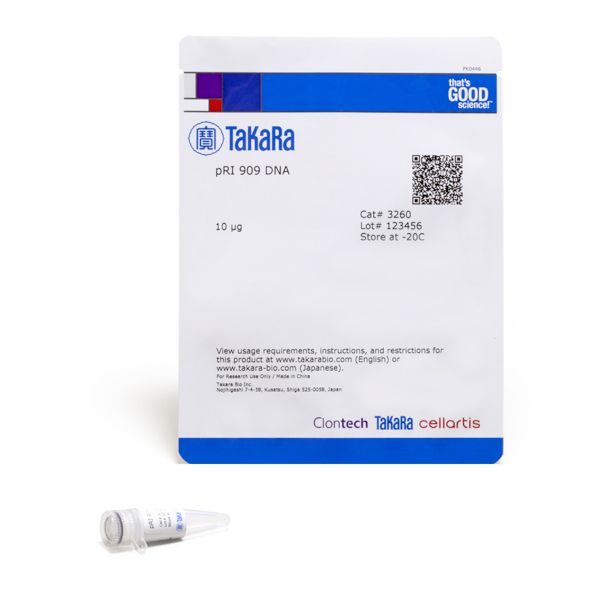pRI 909/910 DNA
pRI 909 and pRI 910 binary vectors
The Ri pRI 909 and pRI 910 binary vectors are intended for Agrobacterium-mediated plant transformation and contain a region of T-DNA for Arabidopsis, tomato, tobacco, and rice transformation. The origin of the T-DNA is the vir region-lacking Rhizobium (Agrobacterium) rhizogenes Ri plasmid. pRI 909 and pRI 910 are also shuttle vectors and replicate autonomously in E. coli and Rhizobium (Agrobacterium).
In E. coli, these vectors are capable of achieving a high copy number because they contain the ColE1 replication origin. The ColE1 ori, as well as the mutant-type Ri plasmid replication of origin (Ri-ori), are each stably maintained in Rhizobium (Agrobacterium). These vectors also contain the kanamycin-resistance gene NPTIII for selection in E. coli and Rhizobium (Agrobacterium), and a mutant-type kanamycin-resistance gene NPTII for selection in plants.
The pRI 909 and pRI 910 vectors are capable of plant transformation in combination with Rhizobium (Agrobacterium) through a binary vector system. Stable plant chromosome target gene integration is possible with pRI 909 and pRI 910 because their cloning sites are located in close proximity to the T-DNA Right Border (RB) and not the NPTII plant selection marker. As a result, the target gene is not deleted.
Overview
- Easy and stable plant chromosome target gene integration
- Improved agrobacterium-mediated plant transformation
- Applicable to various plants such as Arabidopsis, tomato, tobacco, and rice
Applications
- Rhizobium (Agrobacterium)-mediated plant transformation
- Arabidopsis, tomato, tobacco, rice transformation
Purity
- >70% double-stranded covalently closed circular form I (RFI) DNA
- Cloning sites verified by dideoxy DNA sequencing
- Restriction sites verified by restriction-enzyme cleavage
Storage
–20°C
Properties
- Preparation: column purified
- Size: 9,168 bp
Form
10 mM, Tris-HCl (pH 8.0), 1 mM EDTA
Vector map for pRI909 and pRI910

Schematic representation of the Agrobacterium-mediated plant transformation vectors pRI909 and pRI910. The T-DNA contains a mutant-type kanamycin resistance gene, NPTII, for selection in plants under the control of the NOS promoter and terminator with a multiple cloning site (MCS) for cloning your gene of interest. The vectors also contain a ColE1 ori, as well as the mutant-type Ri plasmid replication of origin (Ri-ori) for replication in E. coli and Agrobacterium respectively, and the kanamycin resistance gene NPTIII for bacterial selection.
MCS sequence for pRI909 and pRI910 vectors

DNA sequence of the MCS of Agrobacterium transformation vectors pRI909 and pRI910. The restriction sites are shown. The sequence of the MCS and its neighboring region in pRI909 and pRI910 are orientated in the opposite directions. The M1–M4 sites show the sequences used by these M13 forward sequencing primers, while the RV site represents the M13 reverse sequencing primer location.
Product citations
Nishiguchi, R., Takanami, M., and Oka, A. Characterization and sequence determination of the replicator region in the hairy-root-inducing plasmid pRiA 4b. Mol. Gen. Genet. 206, 1–8 (1987).
Ohba, T., Yoshioka, Y., Machida, C., and Machida, Y. DNA rearrangement associated with the integration of T-DNA in tobacco: an example for multiple duplications of DNA around the integration target. The Plant J. 7, 157–164 (1995).
Ooms, G. et al. Octopine Ti-plasmid deletion mutants of Agrobacterium tumefaciens with emphasis on the right side of the T-region Plasmid 7, 15–29 (1982).


